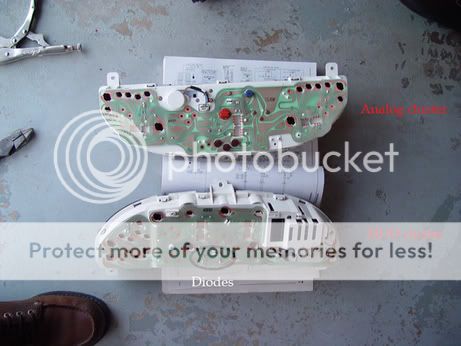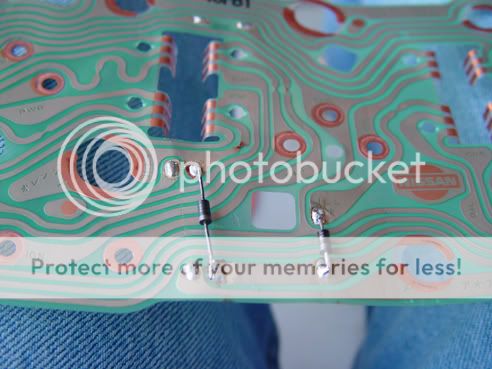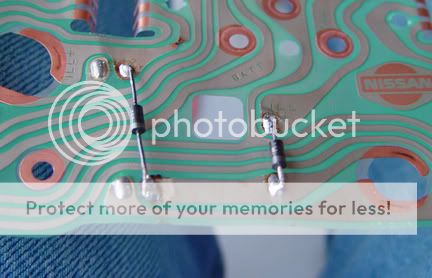THE FIX:
You should now have access to the top of the capacitor. I know this sounds strange, but use pliers and pull the top of the capacitor off (the little aluminum can, it pulls off easily). There will be two, fine wires sticking straight up.
NOTE: Pay attention to the polarity of the new capacitor. Although the capacitor will probably work installed either way, the positive lead should be on the left side when looking at the board as in Photo 2.
You may try to solder the capacitor to these wires if you want. If you get a firm solder joint, great! It will work that way. As the forum posting that we read stated, you may want to secure the capacitor from vibration with a spot of hot glue.
I did not have success soldering to these wires. I had to cut the wires close to the base, remove the plastic base and carefully desolder the leads from the board. Be certain that you remove all metal fragments that you desoldered. DO NOT touch any other component with the iron while desoldering and soldering on the board. When you desolder the leads from the pads, there should be only a tiny amount of solder left on the pads.
Before trying to solder the new capacitor onto the board, bend and shape the leads so they are similar to the shape of the one in the photo. Do not attempt to solder the capacitor down and then bend it into position, the pads could pull off the board which would be tragic.
Test the spacing of the leads on the board before trying to solder. Be sure that they fit the pads closely, do not touch each other and do not cross or touch any other component or pad. When you have the leads shaped correctly, tin the leads with a minute amount of solder. Hold the capacitor in place and touch one lead with the iron. Keep the iron in contact with the lead only as long as it takes to melt the solder. When the first lead joint is solid, solder the second lead. Apply more solder if necessary, but not much. These pads are very close to non-connecting traces and a big blob of solder could risk having an electrical short.
Photo 2
(This photo shows the new capacitor installed)
Carefully inspect your work with a magnifying lens to insure that the joints are solid and are not overlapping other pads or traces. Also check for and remove any fragments of metal on the board.
Photo 3
(This closeup photo shows the capacitor leads and pads.
As you can see, there is a big ball of solder on the left pad.
I left it that way since it did not touch any other traces.)
RETEST:
Completely reassemble the electronic module. As with the first test, hold the module carefully and plug the two cables, from the dash, back into the module. Turn the ignition switch to the RUN position. The panel and the HUD should light up and dispay a zero. If so, everything can be reassambled and you are ready for the road. Go to FINALLY.
WHAT THE HECK?!:
If your installation of the new capacitor did not work;
* is the ignition switch in the 'RUN' position?
* are the cable plugs firmly inserted into the back of the module?
* is the plug on the edge of the module reconnected?
* is the header connector between the top board and the second board seated firmly?
* reinspect your solder joints
* look for tiny pieces of metal (from cutting or desoldering) laying on the board or against other components
* did any of the copper traces on the board get deeply scratched (broken)?
* check the solder joints of the pins that connect the 'capacitor board' to its mother board (Photo 2)
* try another new capacitor
Go to RETEST.
FINALLY:
YeHaa!
We hope that you had as much fun (hmmm...?) as we did, replacing this tiny part. We just considered it another challenge in the long list of challenges associated with automobiles!
'While driving, take no risks, be no threat'
__________________
and annother one, damn... i must be bored?
I searched in many groups about my cluster problem to no avail. I just installed an HUD cluster on my 1989 S13 SOHC.
Symptoms: a week later after cluster installation, I try to shut my car off and all my ACC items will stay on, radio,heater, cluster lights,etc. I thought it was a ignition switch problem. I try restarting the car and it went away...but later that day I noticed that the driving lights and cluster lights were still on, even with the lights switch off and the flip ups were staying up permamently...Something was shorting my illumination path to ground. I went directly to the cluster and double check the harness just in case. I found that by disconnecting the cluster the problem went away...I never trouble shoot a cluster of any kind before, and would like to share my findings.
Troubleshooting: Is not too much to it, and it applies to analog/HUD and maybe even DOHC cluster. Measure all the diodes in the back of cluster. If you find any that are shorten out, replace them. I used old ones from an analog cluster I have for parts. The diodes are the same. Check the pics for the location of the diodes. They handle the illumination of the cluster and clock. Also tied up with the car light system. If you can find an FSM, look up the wire diagram, these two diodes are tied up on one side and by shorting out they were grounding the lights on the car, also confusing the time control unit and creating other issues...flip ups staying up and the ACC function staying on.. After replacing the diodes, all problems solved. Ensure if you have an HUD that your connector for the HUD LCD module is on, if not you will not have cluster illumination. Also to have the blinkers switch connected if not you will not have turn signals, just to keep you from getting confused during final testing. Sorry about the long post, hopefully somebody outhere will benefit from this. And now the pics......

Here you can see the location of the specific diodes and the cannibalized analog cluster, plus a top view of my shoe....
A good look of the flex mat circuit board, BE CAREFUL when handling this part is very delicate....also ensure that you maintain the polarity of the diodes, they only go one way and one way only.
An even closer look, not a perfect soldering job, but it will do....Also you might notice that I soldered the diodes in the wrong side of the board, I had to because I used the old diodes and cut them off from the other cluster and they were too short to be soldered on the back of the HUD cluster. But actually is better this way, because if you need to replace them in the future you will not have to take the circuit board and all lightbulbs to have access to it...just make sure they dont touch any metal in the dash when installed....
Just to give an idea what tools you are going to need......do not apply too much heat to the components or you will damage the tracks on the flex circuit board.....
When you measure diodes, with a multimeter you are looking for a high (ohm) (open circuit)resistance reading with the meter leads measuring across the diode. You will not need power on the cluster to measure resistance (ohms). Now inverse the location of the leads and you get a low (close circuit) resistance reading or almost 0 ohms.....With the bad diodes on my cluster I was getting 0 ohms both ways which indicates a short condition which is not the way diodes work...therefore acting as an piece of wire and grounding the circuit and creating all kinds of fun...

If you like, find a diode somewhere and check it....just for practice and to get an idea of what to look for....they work based on polarity (+) and (-) so by reversing the leads you are simulating the two basic operational conditions of a diode......If you look at the diode theres a little silver band or mark (indicates negative side) on them...thats what you use to orient the diode, so remember which way the original one was facing and make sure the new matches the same orientation.....
When you take the circuit board off the cluster you will see the resistor and 3 or 4 diodes (depending of what type cluster), they are in the back of the flexible circuit board...I replaced the diodes on the original locations of the bad ones but on the opposite side, so instead of being on the inside now they are on the outside...better cool down
Im trying to track the diodes by the markings, should be no problem matching these with a commercial replacement...when I find the right replacement I will update the thread. I see your point, without an extra cluster or parts there will is no way you can repair it...I think a lot of people have lights problem and go crazy thinking something is shorten out, bad switch or miswire when is actually the cluster on the car
After inspecting all the diodes on the cluster, I noticed that they tend to get pretty hot, which might be the main reason why the fail after a while...so make sure when you replace them that you leave enough spacing between diode and circuit board ( bend the diode legs before soldering to where the diode sits high on the circuit) so the heat does not damage the circuits..... hope this helps













